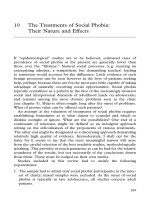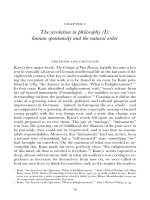The Inside Track - Student Teaching, Volunteering, Subbing, and Temping
Bạn đang xem bản rút gọn của tài liệu. Xem và tải ngay bản đầy đủ của tài liệu tại đây (155.88 KB, 7 trang )
CHAPTER 4
The Inside Track: Student
Teaching, Volunteering,
Subbing, and Temping
T
here are several ways to find the “inside track.” You can impress key people
on a school’s campus as you student teach, work as a volunteer, serve as a
substitute, or fill a temporary teaching vacancy. If you do an outstanding job in any
of these positions, you’re sure to be noticed by the principal, your master teacher,
and others who have hiring authority or can recommend you to those who do.
Don’t pass up a chance to showcase yourself!
Be an Enthusiastic Student Teacher
Your student teaching experience is an important part of your job search: The
evaluations from your university supervisor, master teacher, school site princi-
pal, and others are the most important references you’ll have in your place-
ment file, because they’re from professional educators who’ve seen your
performance in the classroom or have been closely associated with it. These are
the people who’ve evaluated your lessons, classroom-management skills, and
everything you’ve been trained to do over the last few years. These people, for
now, hold your professional life in their hands. You’d better do your best to
impress them!
If you’re already a credentialed teacher who’s
completed your student teaching, you don’t need
to be reminded of the importance of a good, solid
student-teaching performance that results in
great evaluations and letters of reference. But if
you have your student teaching ahead of you, or
if you’re in the middle of it right now, you
should try to impress anyone in a position to
write letters of reference for your placement file.
Of the newly hired
teachers in our survey,
6 percent were hired at
the schools where they
did their student
teaching.
_______________________________________________________ Chapter 4: The Inside Track
© JIST Works
87
You might not be particularly interested in staying in the district where you’re
student teaching, but the impressions you make there will follow you wherever you
go. And if you are interested in the district where you’re doing your student teach-
ing, keep in mind that if they like you they will not want to lose you to another
district! As we researched this book, that fact was made abundantly clear—and it
makes sense. After all, the administrators in that district know you; they’ve seen
what you can bring to their schools and to their kids. So if you make a positive
impression on the teachers and administrators, they’re going to want you some-
where in their district. It’s a win-win deal!
Give Them Something Extra
In most student-teaching situations, you’re given a prescribed schedule to
follow. For instance, in your first week or so you’ll probably observe your
master teacher and get to know the students in the class—and all their names.
You’ll gradually take on more teaching responsibilities until you “go solo,”
when you take over the class by yourself and your master teacher stays behind
the scenes as much as possible. Then, toward the end of your assignment, the
master teacher will ease back into the teaching scene to smooth the transition
when your solo stint is over.
Here’s some helpful advice as you begin your student-teaching experience:
From the very start, even during the observation period, make creative sugges-
tions for things you can do to help your master teacher. For example, you
might suggest such things as constructing a bulletin board, handling the
attendance duties, or taking lunch count. Also, think of any skills you have
that are related to teaching. (Remember the transferable skills we talked about
in chapter 1?) These will help you develop a relationship with the kids, as well
as showcase something special you can bring to the classroom.
If you’re artistically talented, for example, you can add something to the room
environment. If you play the guitar, think of a fun song you can teach the
class. If the students are older and think it’s not cool to sing “Puff the Magic
Dragon,” think of another, more age-appropriate song. The point is this: If
you follow your prescribed student-teaching schedule to the letter and never
offer anything special, you’re missing an opportunity to showcase yourself and
begin the process of “selling your product,” even at this early stage.
Another Chance to Network
Another good idea is to create a network with other student teachers at your
school, sharing information and getting to know them well. This can really
pay off when you’re further along in your job search. (We’ll talk more about
this valuable idea in chapter 6.)
Inside Secrets of Finding a Teaching Job _____________________________________________
© JIST Works
88
Don’t limit your networking to your fellow student teachers, however. The
principal, assistant principal, and mentor teachers can all help you land that
plum teaching job. And never underestimate the power and influence of
school secretaries—you can take it to the bank that they know what’s going
on! Definitely befriend them.
Your network should include the full-time teachers at the school, as well.
They often know influential people within the district. You never know, one
of them might even be a close friend, a spouse, or related to someone in the
district with hiring authority. We heard from several student teachers and
substitute teachers in our survey who took advantage of these contacts to land
great teaching positions.
So take your student-teaching experience seriously. Plan on putting in long
days and going the extra mile. Be in the classroom early, and be there every
school day. Take advantage of every opportunity to teach and interact with
students. Be dedicated; be enthusiastic.
Get Good Reference
Letters
The most important letter of
reference you’ll have in your
placement file is the one from
your master teacher. After all,
that person has worked more
closely with you on a daily basis
than anyone else. Make it easy
for him or her to write an
excellent letter.
Here are two examples of what your master teacher might say:
“Cliff Johnson was a student teacher in my classroom during the spring semester of
2003. His attendance was satisfactory and he was usually punctual. He maintained
adequate classroom control. His lessons indicated planning….”
Or:
“Cliff Johnson was a student teacher in my classroom during the spring semester of
2003. He arrived early and stayed late each and every school day. His classroom
control was excellent. He enthusiastically presented well-prepared lessons….”
“You should have outstanding
recommendations, so work
hard at whatever you do, and
go above and beyond while
you’re a student teacher.”
—Member of an interview
committee in Miami, Florida
_______________________________________________________ Chapter 4: The Inside Track
© JIST Works
89
If you were screening applications and ran across these two letters, which
would impress you the most? The answer is obvious. We can’t overemphasize
the importance of your student-teaching experience and its impact on your
job search.
If you do a good job, people will hear about you. Principals talk to other
principals, teachers to teachers, parents to parents. It’s like the pebble in the
pond and its concentric waves. Never underestimate the role of chance in
getting a job. Think of all the people you know who got their jobs in some
strange way: “So and so” knew “so and so” who heard from “so and so” about a
job over in Pikeville. You might say the more “so and sos” who know you, the
better chance you have of getting a job!
Become an Enthusiastic School
Volunteer
Doing volunteer work at a school is another way to make yourself known. If
you have something to offer young people in the classroom, it’ll show up
when you volunteer to help out at a school; and the more exposure you get
within the educational community, the better your chances to become known
by those with hiring authority.
For starters, think about joining the school’s parent-teacher organization. Not
only will you get to know the school’s principal and teachers, but they’ll
recognize your commitment to kids and to education. They’ll also get a sense
of your attitude and work ethic.
As a classroom volunteer as well, there are many ways to impress a particular
teacher as you showcase your skills, talents, and love of children. For example,
if you accompany the class on a field trip and help the teacher cope with
the inevitable mini-crises that happen along the way, you’ll create a positive
impression; and you can count on your excellent reputation filtering back to
the principal and other teachers at the school.
At the secondary level, take whatever special talents you have—whether in
drama, music, athletics, foreign languages, or fund-raising—and volunteer to
use them in some way. You might volunteer as a chaperone for school dances.
Or you might work with a class on their yearbook, coordinate homecoming
activities, or help plan the decorations for the junior-senior prom. There are
dozens of ways to help out—it just takes some creative thinking.
Inside Secrets of Finding a Teaching Job _____________________________________________
© JIST Works
90
By offering your services as a school volunteer, not only will you be helping
the kids and the staff, you’ll be putting yourself on the inside track to teach-
ing vacancies as they come up—and that’s the bottom line. Look at it this
way: School volunteerism is just one more way to keep your “net working.”
After all, the more territory your net covers, the more you make yourself
known—and, as we’ve already learned, the first rule of the job search is to
become known!
Become an Enthusiastic Sub or Temp
As we researched this book, we talked
to many teachers who were hired by
the school or district where they had
worked as substitute teachers. Some
had subbed on a day-to-day basis;
others had filled part-time or
temporary positions. If you’re
having trouble finding a full-
time job, this might be the
route for you.
Short-Term Subbing
If you decide to try subbing, it’s important to be available when a school calls.
And, although the telephone shouldn’t dominate your life, it can certainly put
a kink in your day. You might resent having to sit by the phone certain times
of the day waiting for that call.
To get your name on the sub list, call the personnel office, which will instruct
you on the district’s policies. Every district’s policies are a little different. If
you have your heart set on subbing at only one or two specific schools, you
might need to state that when you call the personnel office, or you might
need to call the school itself because some schools have their own sub lists.
Usually you’ll be called before 7 A.M. Someone from the school or the sub
service will ask if you’re available to take a certain class for that day. You always
have the option to decline, of course, and on occasion you’ll have to, for any
number of reasons. But if you want to maintain a good working relationship
with a district, don’t make a habit of turning them down. If you do, they’ll
stop calling. Of course, if you’re signed up to sub with several districts, there
will be times you’re forced to decline one job because you’ve already taken
another, which is one of the disadvantages of spreading yourself too thin.
Of the newly hired teach-
ers in our survey, 13
percent were hired for full-
time positions at the
schools where they had
worked as substitute
teachers.









